Heaves and Inflammatory Airway Disease in Horses

Heaves and inflammatory airway disease (IAD) are important causes of allergic lower airway disease in horses. Horses with heaves tend to be older and have respiratory difficulty at rest (increased effort and rate of breathing, flaring of the nostrils, coughing, and mucus in the trachea and occasionally in the nostrils). Inflammatory airway disease primarily affects younger horses, such as those in training or recently put into work. Horses with IAD do not show signs of respiratory difficulty at rest but may cough, have increased mucus in the trachea, and have decreased performance.
Causes
Both of these conditions are caused by inhaled allergens from the horse’s environment. The lower airways in the lungs respond to inhaled irritants by constricting (which reduces airflow), overproducing mucus, and decreasing clearance of mucus from the respiratory tract. Horses kept in stalls are exposed to large amounts of irritant particles and mold spores from dust, hay, and bedding. Susceptible horses are often allergic to other inhaled irritants such as pollen. For this reason, affected horses can worsen or show clinical signs only at certain times of the year.
Diagnosis
Diagnosis of heaves and IAD is usually straightforward. Physical examination and auscultation of the chest often reveal increased lung sounds (crackles and wheezes) and an increased abdominal push at the end of expiration with heaves. This increased effort to expel air can actually enlarge the muscles at the bottom of the chest and abdomen, which creates a “heave line,” a muscle prominence that typically parallels the contour of the underline. It is also important to rule out bacterial pneumonia or recent viral respiratory tract infection.
Endoscopy will reveal increased mucus in the trachea. Diagnosis is best made by performing a bronchoalveolar lavage (BAL). This procedure involves passing a flexible tube or endoscope into the lower airway of the horse, injecting saline, and then aspirating the fluid to collect a sample of the cells in the small airways. This fluid is examined using a microscope, and an increase in white blood cells and mucus confirms the diagnosis. Differentiation of heaves and IAD involves the types and numbers of white blood cells observed. Sometimes horses may also have bacterial lung infections along with reactive airway disease, especially heaves.
Environmental Management
The most important treatment for any reactive airway disease is to minimize dust and inhaled irritants in the horse’s environment. Any other treatment will not work as well without changing the horse’s environment. Ideally, affected horses are turned out at all times and are never stabled or fed indoors. Bedding on straw should be avoided. Alternate bedding materials include wood shavings or pellets and shredded cardboard. Researchers have shown that affected horses are asymptomatic when kept on pasture but will develop clinical signs within a few days if housed in stalls and bedded on straw. Horses on pasture can develop heaves (summer pasture-associated obstructive pulmonary disease) at certain times of the year, especially during warm summer months.
Medical Management
Airway irritation is best managed using corticosteroids such as dexamethasone or prednisolone. Corticosteroids have been shown to improve lung function and breathing effort, even when horses were kept in dusty environments. Corticosteroids can be administered orally or by injection or inhalation. Several masks or nasal devices are marketed to fit inhalers used in humans with asthma. The Web sites of these companies are excellent sources of information about reactive airway disease and how these devices can be used for treatment. Some horse owners prefer inhalant therapy to avoid possible adverse effects or to meet requirements for competition.
Bronchodilators such as clenbuterol open up the airways and improve clearance of mucus from the respiratory tract. It is important to keep horses receiving clenbuterol on steroids at the same time because its efficacy will decrease over a few days unless corticosteroids are also administered. It usually takes 7-10 days of initial treatment along with environmental changes before treatments can be reduced or discontinued. Some horses with longstanding or severe heaves have such extensive remodeling and scarring of their lower airways that no treatment will be effective. Antihistamines tend to be ineffective for the treatment of heaves or IAD.
Nutritional Management
Good-quality hay should be fed whenever possible. Feeding hay on the ground allows horses to naturally clear mucus from their airways and also decreases the amount of mold spores and dust that they breathe while eating, as even good-quality hay is loaded with mold spores. Hay can be soaked to minimize dust particles, though many horses will not eat soaked hay. There are some convenient hay steamers available that steam-heat hay to reduce mold spores while keeping the forage palatable. Alternative sources of forage such as hay cubes, haylage, or complete pellets can also be fed. Round bales should be completely avoided.
Most horses with heaves or IAD can be managed and return to their desired level of work. However, owners must commit to improving their environment. Affected horses are often worse at certain times of the year and treatment can begin early to prevent a sudden acceleration of clinical signs.








